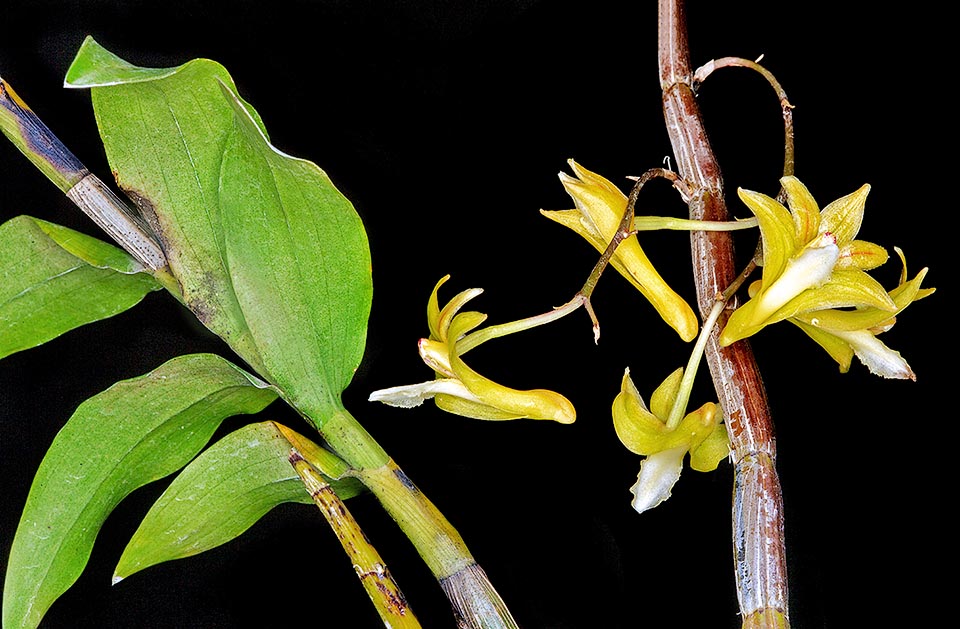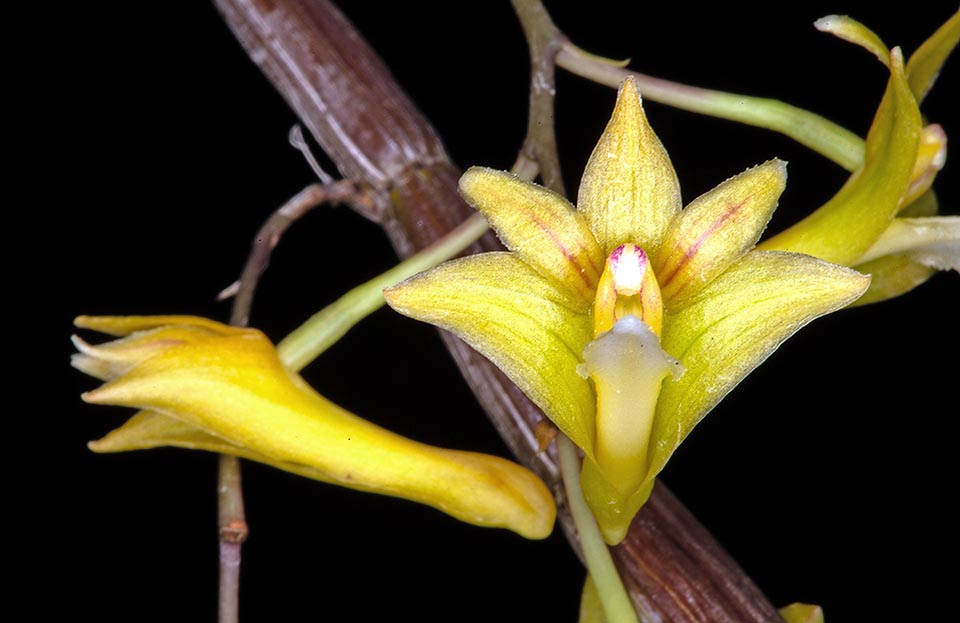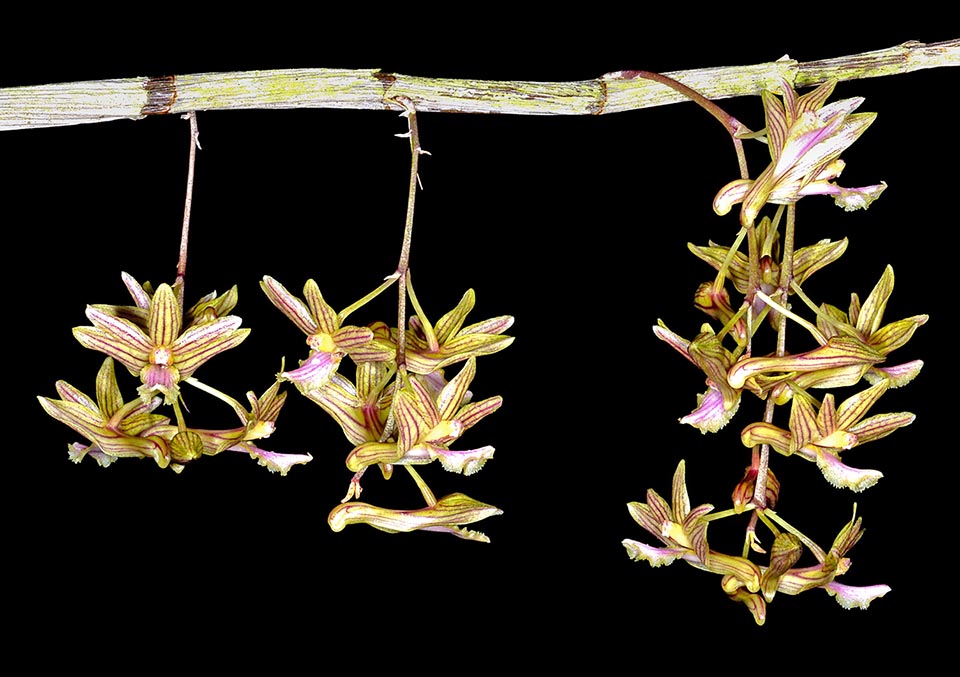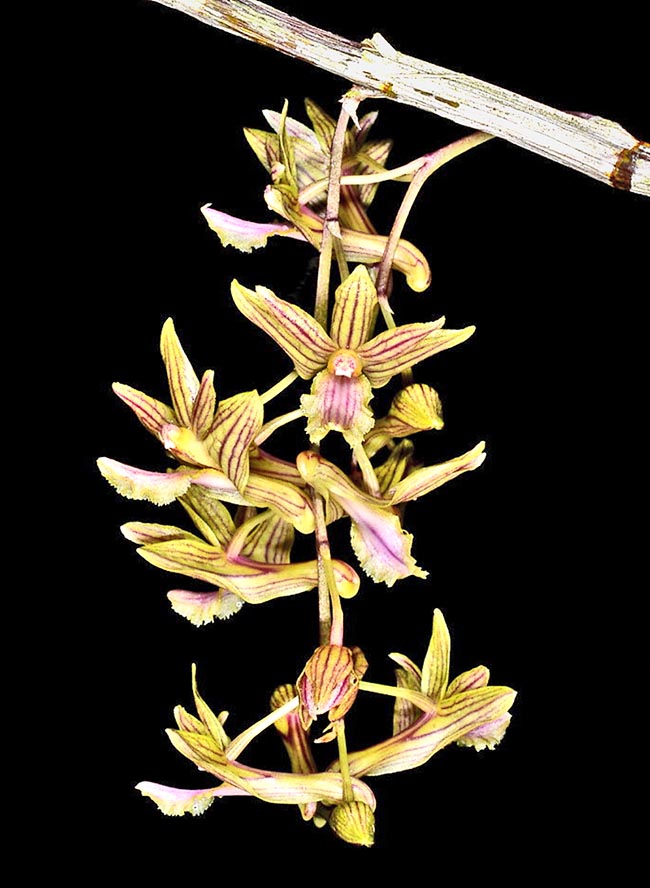Family : Orchidaceae

Text © Prof. Pietro Pavone

English translation by Mario Beltramini

Dendrobium floresianum is a 40-80 cm epiphyte of Flores Island, in Sunda Lesser Islands, with erect fusiform pseudobulbs, similar to canes, and lanceolate leaves © Giuseppe Mazza
Dendrobium floresianum Metusala & P.O’Byrne is a species of the family Orchidaceae, subfamily Epidendroideae, tribe Malaxideae, subtribe Dendrobiinae, section Calcarifera.
This species has been by chance discovered in the island of Flores (Lesser Sunda Islands, Indonesia) in 2006 by the researcher Destario Metusala (1983- ) of the Indonesian Institute of Sciences (Lembaga Ilmu Pengetahuan Indonesia, LIPI) and by the Singaporean researcher Peter O’Byrne (1955-2018).
The publication in the scientific magazine Orchid Rev. 117:99 (2009) took place after a research lasting three years that have been essential for having the certainty that the orchid was really different from the other species similar to the same genus.

The non fragrant yellowish flowers are about 3 cm broad and 4 long. The dorsal sepal and the petals have longitudinal red stripes. The labellum is white © Giuseppe Mazza
Peter O’Byrne has been an orchid scholar and author of a very successful opus: Lowland Orchids of Papua New Guinea, published in 1994. After this initial success he described as many as 317 new species for Science establishing himself as a living authority of Southeast Asia and of New Guinea orchids. Unfortunately due to a cardiovascular insufficiency he passed away in August 2018 while he was in Kew to complete his revision project of the genus Dendrobium section Crinifera present in peninsular Malaysian flora.
Dendrobium floresianum grows, up to 600 m of altitude, in the island of Flores so called by the Portuguese, who reached the island in the XVI century, because of the showy flowerings of Delonix regia they met in Cape Kopondai, in the eastern part of the island, that they named Cabo de Flores (“Cape of the flowers”).

Various cultivars exist. For the growth substratum can be utilized a well drained mix of sphagnum moss and of fir bark © Ron Parsons
The island of Flores belongs to the Lesser Sunda Islands, or Nusa Tenggara Islands, that form an archipelago in Southeast Asia and are part of a volcanic arc, called Sunda Arc, that has formed via the subduction of the Australian Plate under the Eurasian Plate originating the Sunda Trench in the Java Sea reaching a depth of 7725 m.
The islands are populated by deciduous forests and, on the higher slopes, by woods of Engelhardia and by forests of conifers (Podocarpus). The undergrowth is formed by lianas and epiphyte plants. In the coastal plains of Komodo, Rinca and Flores, formerly, were present sparse forests of palms (Borassus flabellifer) and herbaceous plants typical to the savannah.

Cultivation is easy, but the lovely inflorescence is not long-lasting © Ron Parsons
The name of the genus Dendrobium is the combination of the Greek substantives “δένδρον” (dendron), tree and “βίος” (bios), life, due to the numerous species of the genus that live on the trees getting their food from the humid atmosphere, typical of the equatorial forests.
The specific epithet refers to the island of Flores, where it has been found.
Dendrobium floresianum is a medium-sized epiphyte (40-80 cm) with fusiform pseudobulbs, erect, similar to canes, with several lanceolate and sharp leaves. The inflorescence is formed by 5 to 7 flowers and may be arcuate or pendulous. The flowers, not fragrant, are about 3 cm broad and 4 cm long with green yellow sepals and tepals. The dorsal sepal and the petals have three longitudinal red stripes. The lateral sepals are wide and horizontally arranged. The labellum is white. In the origin locations, the blooming occurs in April-May, September-October and January and the single flowers last 7-10 days.
Dendrobium floresianum is a species inscribed in the Appendix II of Washington Convention (CITES) that has the aim of protecting the animal and vegetable species against the risk of extinction, preventing their export and detention.
Dendrobium floresianum is also an ornamental species easy to cultivate. It requires warm temperatures and high humidity. It’s a good practice to maintain also a good air circulation, with non direct light, but from 50% to 70%.
For the growth substratum may be utilized a well drained mix of sphagnum moss and of fir bark.
In summer is to be regularly watered and monthly fertilized, whilst in winter the waterings are to be reduced until the appearance of new buds. Like other species of Dendrobium, attention is to be paid to the cochineals that may infest the plant. If they are present, they must be removed with a cotton ball or a swab soaked in alcohol or in Neem oil and soap.
The cultivar Dendrobium floresianum ‘Springwater’, created by Thanh Nguyen, owner of Springwater Orchids (Melbourne, Florida, USA), on 4/29/2016 has received from the American Orchid Society the Horticultural Merit Certificate (CHM).
Dendrobium floresianum f. flava can be 40 cm tall and displays flowers of pale green-yellow colour including the peduncle.
